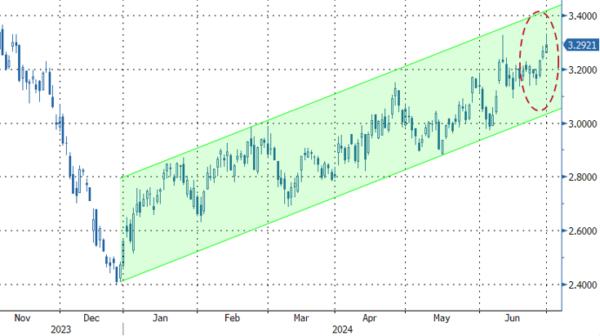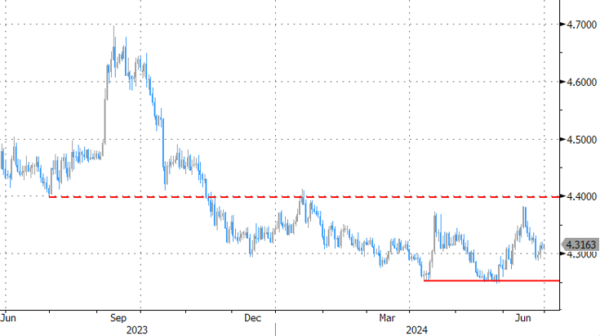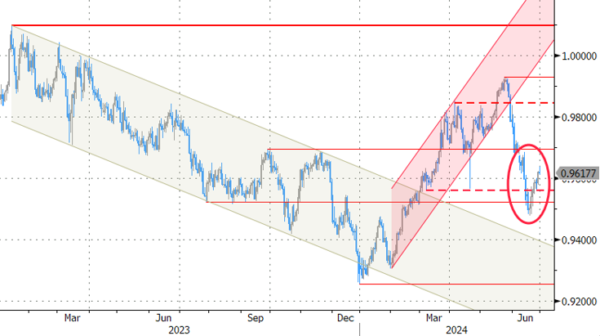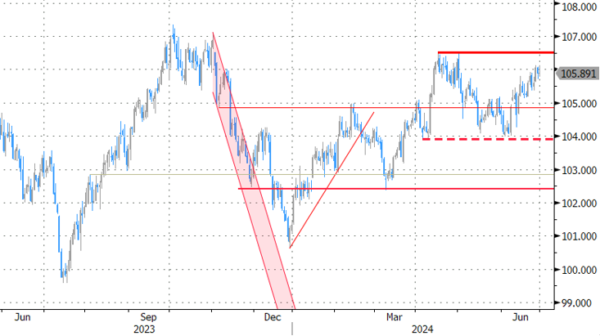Markets
Today’s avalanche of inflation numbers had little surprises in store. Euro area member states France (0.1% m/m, 2.6% y/y) and Spain (0.3% m/m, 3.5% y/y) reported theirs ahead of the June European figure next Tuesday. Both printed bang in line with expectations, suggesting an outcome close to the European consensus of 2.5%. US May PCE deflators were up next, coming in … bang in line with expectations. The headline index was flat on the month and eased from 2.7% to 2.6% y/y. The core gauge rose 0.1% m/m and 2.6% y/y with an upward revision of the April reading to 0.3% m/m. The CPIs published earlier this month, if anything, entailed risks for a downside surprise. So to see US yields still snap lower (daily losses between 0.5 and 4.5 bps) on a PCE exactly as expected tells a lot about the current market sentiment. The end of the quarter is likely to have supported a more technical bid as well, in particular since it coincides with an important weekend. The first round of the snap French parliamentary elections takes place this Sunday. Market nervousness translates into French asset underperformance. The CAC40 loses 0.7% vs other European indices trading flat to only marginally lower. The OAT/Bund spread rises 4 bps, more than semi-core peers including Belgium (flat) and comparable to daily changes in the European periphery (Italy +3 bps, Spain +6 bps, Portugal +1 bps, Greece +2 bps). On a yield level, the French 10-yr tenor briefly surpassed the previous YtD high seen in the aftermath of Macron’s announcement. This compares to the German reference that’s still trading 20+ bps below the YtD. A wary euro is unable to profit from UST outperformance. EUR/USD trades around the 1.07 barrier. Election fever is spreading from the European mainland to the UK on Thursday. General elections are all but certain to bring Labour back into power after 14 years in the opposition. Europe continues to take center stage next week with the ECB’s Sintra conference (“Monetary policy in an era of transformation”) kicking off. One of the attention grabbing themes is about the drivers of the equilibrium interest rates. ISM business confidence and the June payrolls report is due in the US.
News & Views
Polish consumer prices in the country in June rose 0.1% M/M and 2.6% Y/Y (was 0.2% M/M and 2.5% Y/Y in May), Statistics Poland revealed today. The figure was marginally softer than expected. Prices of food and non-alcoholic drinks increased 0.7% M/M, but electricity and gas prices declined 0.1% M/M while fuel prices were 2.8% lower compared to May. Headline inflation is within the 2.5% +/- 1.0% target range of the National Bank of Poland (NBP) since February. Even so, the NBP at the June meeting reiterated that inflation developments are associated with substantial uncertainty related to the impact of fiscal and regulatory policies as well as to the pace of economic recovery. Higher energy prices (removal of price cap) and demand pressures due to strong wage growth might cause inflation to rise in the second half of the year. Most MPC members, including Governor Glapinski, recently held to the communication that rate cuts this year (policy rate 5.75%) are unlikely. The next NBP policy decision is scheduled for Wednesday next week. After a risk-off driven setback early this month, the zloty again trades to the stronger side of the EUR/PLN 4.25/4.41 trading range that guided trading this year (currently 4.31).
The Swiss National Bank (SNB) reported it bought a limited amount of CHF 281 mln in foreign currency in Q1. This is a sharp turnaround compared last year when it sold substantial amounts of foreign currency/bought CHF to support the franc to help bring inflation back to target (amount CHF 22.7 bln in Q4 2023). The SNB didn’t give any comment. However, as inflation returned to the 0 %-2.0% target and SNB even cut its policy rate in March and this month, CHF purchases didn’t fit in the SNB’s policy anymore. At the press conference after the June 20 SNB decision, Governor Jordan indicated that the SNB could intervene in the CHF in both directions. Also today, the KOF Swiss economic Institute reported that its economic barometer increased from 102.2 tot 102.7. The index stays in a slightly above average range since the beginning of the year. The rise is primarily due to a more favourable outlook for foreign demand. The hospitality industry also benefits more strongly. The indicator bundles for manufacturing, construction and private consumption are virtually unchanged in June. In contrast, the outlook for financial and insurance services and other services is slightly gloomier. The Swiss franc since the June 20 SNB decision declined from EUR/CHF 0.948 to currently 0.9625.
Graphs
French 10-yr yield briefly this new YtD high ahead of first round in Sunday’s parliamentary elections

EUR/PLN: zloty back towards stronger side of a sideways trading range after a risk-off driven correction lower early June

EUR/CHF: CHF ready to catch some post-election safe haven bids?

DXY struggles near 106 barrier after in-line PCE triggers UST bid










